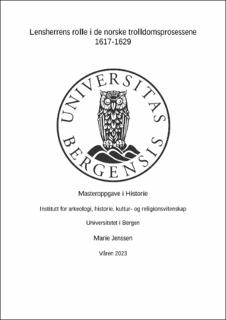| dc.description.abstract | In this master's thesis, I investigated the role of the district governor in the Norwegian witchcraft trials in the period 1617-1629. The district governors were royally appointed officials, who maintained the areas subject to the Danish crown on behalf of the king. The district governor had several administrative tasks which included tax collection, military administration, and supervision of the church and the judiciary. Most important for this thesis has been the district governors` supervision of the judiciary, and their task of implementing state policy at local level. In October 1617, the king issued the ordinance "om trollfolk og deres medvitere”. The ordinance identified "the right witches" as those who formed a pact with the devil. In addition, the ordinance contained a clear command to the country's authorities that they should prosecute and punish all suspected witches. This thesis has shown that the district governor was involved in approx. 40% of witchcraft trials where the sources document the actors who were present at the trials. The district governors from Verne Kloster, Akershus, Stavanger, Vardøhus, Bratsberg, Eiker, Agdesiden and Nordlandenes districts were involved in witchcraft trials. However, the district governor's involvement in the witchcraft trials took many different forms. Some appeared to be instigators of the processes, some were involved, but their influence is difficult to conclude, and some acquitted the accused. Nevertheless, the district governor actively followed up the 1617 regulation's commandment to supervise cases of witchcraft. According to the source material, it is clear that witchcraft trials were unique in the legal system. The district governors do not seem to have been involved in the legal system apart from the purely administrative tasks they were required to do, and these tasks were not always carried out either. My findings match former research on district governors in other Norwegian districts. I have nevertheless shed light on new aspects of the district governors’ administrative duties in the legal system, such as their ability to pardon the convicted on behalf of the king. We see a decline in the number of witchcraft trials around 1628-1629. In the source material, I found an increased focus on warfare in connection with Denmark-Norway's involvement in the Thirty Years' War. I hypothesize that the state's focus was therefore on external enemies, rather than internal ones. The thesis is delimited by the Church Discipline Ordinance of 1629, so the framework for the master's thesis is two ordinances concerning morality and religion that sought to discipline the population. | |
